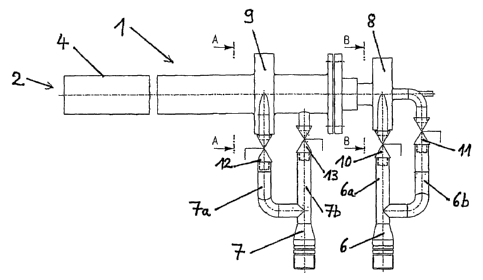Note: Claims are shown in the official language in which they were submitted.
7
Claims
1. Externally mixing burner (1) having a burner head (2), at least one
combustion gas tube
(3) and at least one tube (4) for an oxygen-containing gas, whereby the burner
head (2)
has outlet openings out of the combustion gas tube (3) and out of the tube (4)
for the
oxygen-containing gas, characterized in that gas inlet lines (6, 7) are
provided for the
combustion gas and for oxygen-containing gas, each being connected to a source
for
combustion gas and/or for oxygen-containing gas, respectively, and of these,
at least one
gas inlet line (6, 7) opening eccentrically into a swirl chamber (8, 9), which
is arranged
between the gas inlet line (6) and the combustion gas tube (3) and/or between
the gas
inlet line (7) and the tube (4) for oxygen-containing gas.
2. Burner (1) according to Claim 1, characterized in that at least one of the
gas inlet lines (6,
7) is divided into two lines (6a, 6b, 7a, 7b) upstream of the swirl chamber
(8, 9), whereby
one of these lines (6a, 7a) opens eccentrically into the swirl chamber (8, 9)
and the other
of these lines (6b, 7b) opens directly into the combustion gas tube (3) and/or
into the tube
(4) for oxygen-containing gas.
3. Burner (1) according to Claim 1 or 2, characterized in that valves (10, 11,
12, 13) are
provided in the gas inlet lines (6, 7), in particular valves (10, 11, 12, 13)
being provided
in the part of the gas inlet lines (6, 7) in which at least one gas inlet line
(6, 7) is already
divided into two lines (6a, 6b, 7a, 7b), and a control unit or regulating unit
is available,
controlling or regulating the degrees of opening of the valves (10, 11, 12,
13), so that the
shape of the flame of the burner (1) is adjustable.
4. Burner (1) according to one of Claims 1 through 3, characterized in that
the valves
(10, 11, 12, 13) are designed as solenoid valves (10, 11, 12, 13).
5. Burner (1) according to one of Claims 1 through 4, characterized in that
the swirl
chamber (8, 9) has a circular cross section in a section perpendicular to the
longitudinal
axis of the combustion gas tube (3).
6. Burner (1) according to Claim 5, characterized in that the gas inlet line
(6, 7, 6a, 7a)
opens tangentially into the swirl chamber (8, 9).
7. Method for operating an externally mixing burner (1) having at least one
combustion gas
tube (3) and at least one tube (4) for oxygen-containing gas, through which
combustion
gas and/or oxygen-containing gas flows to the burner head (2), characterized
in that the
combustion gas and/or the oxygen-containing gas is introduced eccentrically
into a swirl
chamber (8, 9) in which a swirl flow is impressed upon the combustion gas
and/or the
oxygen-containing gas and the combustion gas and/or oxygen-containing gas is
supplied
to the combustion gas tube (3) and/or the tube (4) for oxygen-containing gas
after leaving
the swirl chamber (8, 9).
8. Method according to Claim 7, characterized in that the quantities of
combustion gas and
oxygen-containing gas supplied to the burner (1) per unit of time through the
swirl
chamber (8, 9) and without the swirl chamber (8, 9) are controlled and/or
regulated,
whereby the combustion gas and the oxygen-containing gas are sent through
valves (10,
11, 12, 13) whose degrees of opening are controlled or regulated so that the
burner (1)
produces a flame having a desired shape which is adjustable via the control
and/or
regulating unit.
9. Method according to Claim 7 or 8, characterized in that air is used as the
oxygen-
containing gas.
10. Method according to Claim 7 or 8, characterized in that oxygen-enriched
air is used as
the oxygen-containing gas.
11. Method according to Claim 7 or 8, characterized in that a gas having an
oxygen content
greater than the oxygen content of air, in particular an oxygen content
greater than
30 vol%, is used as the oxygen-containing gas.
12. Method according to Claim 11, characterized in that a gas having an oxygen
content
greater than 70 vol%, in particular greater than 99.5 vol%, is used as the
oxygen-
containing gas.
9
13. Method according to one of Claims 7 through 12, characterized in that a
swirl flow is
impressed upon the combustion gas flow.
14. Method according to one of Claims 7 through 13, characterized in that a
swirl flow is
impressed upon the flow of oxygen-containing gas.
15. Method according to one of Claims 7 through 14, characterized in that co-
rotating swirl
flows are impressed upon the combustion gas flow and the flow of oxygen-
containing
gas.
16. Method according to one of Claims 7 through 14, characterized in that
contra-rotating
swirl flows are impressed upon the combustion gas flow and the flow of oxygen-
containing gas.
17. Use of the externally mixing burner (1) according to one of Claims 1
through 6 for
melting metal or glass.
